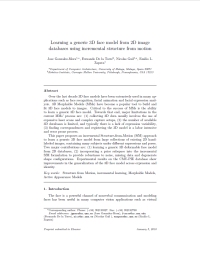Learning a generic 3D face model from 2D image databases using incremental structure from motion

People
- Jose Gonzalez-Mora
- Fernando De la Torre
- Nicolas Guil
- Emilio L. Zapata
Abstract
Over the last decade 3D face models have been extensively used in many applications such as face recognition, facial animation and facial expression analysis. 3D Morphable Models (MMs) have become a popular tool to build and t 3D face models to images. Critical to the success of MMs is the ability to learn a generic 3D face model. Towards that end, major limitations in the current MMs' process are: (1) collecting 3D data usually involves the use of expensive laser scans and complex capture setups, (2) the number of available 3D databases is limited, and typically there is a lack of expression variability, (3) finding correspondences and registering the 3D model is a labor intensive and error prone process. This paper proposes an incremental Structure-from-Motion (SfM) approach to learn a generic 3D face model from large collections of existing 2D handlabeled images, containing many subjects under different expressions and poses. Two major contributions are: (1) learning a generic 3D deformable face model from 2D databases, (2) incorporating a prior subspace into the incremental SfM formulation to provide robustness to noise, missing data and degenerate shape configurations. Experimental results on the CMU-PIE database show improvements in the generalization of the 3D face model across expression and identity. Key words: Structure from Motion, incremental learning, Morphable Models, Active Appearance Models
Citation

|
Jose Gonzalez-Mora, Fernando De la Torre, Nicolas Guil, and Emilio L. Zapata
"Learning a generic 3D face model from 2D image databases using incremental structure from motion" Accepted for publication in Image and Vision Computing, 2010. [PDF] [Bibtex] |
Acknowledgements and Funding
This work was partially supported by the Ministry of Education and Science (CICYT) of Spain under contract TIN2006-01078 and Junta de Andalucia under contract TIC-02800. Thanks to the University of South Florida (USF) and the University of Freiburg for providing the Human ID 3D Database and the 3D Morphable Model. Thanks to Jeff Cohn for providing a partial labeling of the Multi-PIE database. Thanks to L. Torresani for providing a publicly available implementation of their SfM algorithm.
Copyright notice
| Human Sensing Lab |